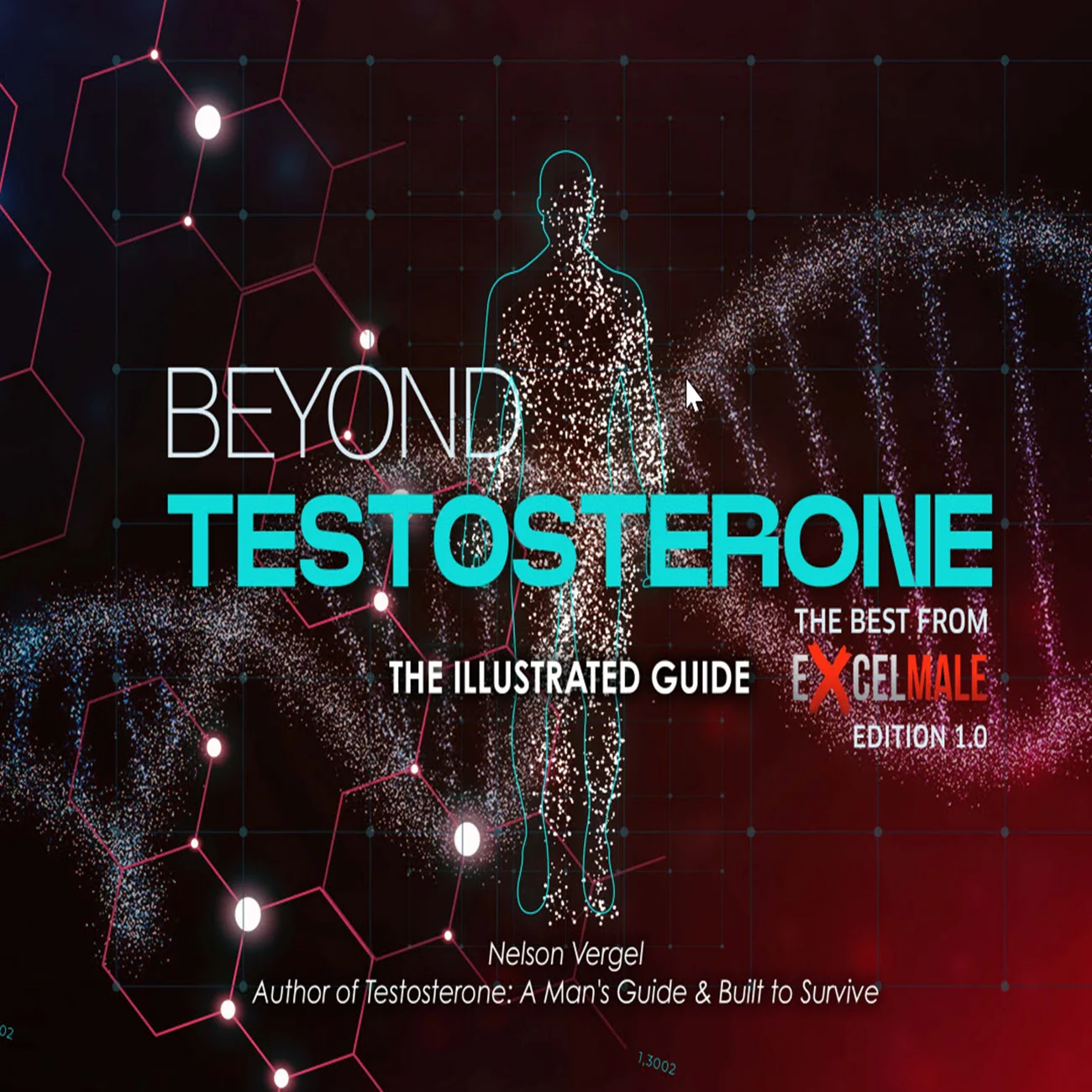Nelson Vergel
Founder, ExcelMale.com
Briefing Document: The Link Between Muscle Quality and Erectile Dysfunction
Date: July 21, 2025 Source: "Exploring the link between muscle quality and erectile dysfunction: assessing the impact of mass and strength" (Sexual Medicine Reviews, 2025)I. Executive Summary
This briefing document summarizes key findings from a recent review exploring the relationship between skeletal muscle health (mass and strength) and sexual function, particularly erectile dysfunction (ED). The review highlights that skeletal muscle parameters are emerging as independent biomarkers for sexual health, with significant implications for overall well-being. While testosterone plays a crucial role in both muscle and endothelial health, the research indicates an independent positive correlation between erectile function and muscle quality, especially in aging men and those with comorbidities. Maintaining skeletal muscle through proper nutrition and physical activity is presented as a vital strategy for improving both erectile and general health outcomes. The document also discusses the physiological mechanisms underlying this link and potential therapeutic interventions.
II. Main Themes & Key Findings
A. Muscle Health as an Independent Predictor of Sexual Function:
- Emerging Biomarker: Skeletal muscle mass and strength are increasingly recognized as important indicators for overall health, including sexual function. The study states, "Skeletal muscle mass and strength are emerging biomarkers for overall health. Considered in tandem, sexual function and muscle mass have significant implications for well-being."
- Independent Correlation: Despite the well-established influence of testosterone on muscle and endothelial health, a crucial finding is that "an independent correlation between HGS and International Index of Erectile Function-5 (IIEF-5) score persists after adjustment for serum testosterone (β = .169, P = .037) showing the strength of this relationship independent of testosterone." This suggests that even with normal testosterone levels, poor muscle health can contribute to ED.
- Clinical Implications: Routine assessment of muscle function (e.g., Hand-Grip Strength (HGS), Bioelectrical Impedance Assessment (BIA)) could help identify patients at risk for sexual dysfunction, even when traditional hormonal or cardiovascular markers appear normal.
- Metabolic Regulation: Skeletal muscle plays a central role in metabolic processes, which directly impact endothelial health and, consequently, erectile function.
- Glucose Uptake & Insulin Sensitivity: Skeletal muscle is a primary site for glucose uptake (up to 80% of postprandial disposal) and improves insulin sensitivity. "Since hyperglycemia and insulin resistance are associated with endothelial dysfunction and reduced nitric oxide bioavailability, both critical for sexual function, the ability of skeletal muscle to act as a glucose sink is vital."
- Lipid Regulation: It is also a key site for fatty acid oxidation, which "prevents lipid accumulation, reduces circulating triglycerides, and improves HDL levels, which protects endothelial function."
- Endothelial Function: Processes predisposing to atherosclerosis (e.g., aging, low muscularity) cause endothelial dysfunction and ED. There's a bidirectional relationship where "endothelial function may affect muscular health," with endothelial dysfunction potentially leading to muscle fiber ischemia and atrophy.
- Inflammation: Unfavorable body composition (high fat, low lean muscle) contributes to insulin resistance and inflammatory states, which suppress testosterone production and exacerbate sexual dysfunction. "Chronic inflammation affects both skeletal muscle and sexual function."
- Pelvic Floor Strength: Overall muscular strength contributes to the strength of pelvic floor muscles, which are "crucial for maintaining erectile rigidity in men."
- Oxidative Stress: Exercise, vital for muscle maintenance, mitigates oxidative stress, "enhancing the efficiency and longevity of mitochondria, reducing oxidative stress that enhances the systemic production of NO, protecting erectile function."
- Normal Population: Even in men reporting no loss in muscle strength, there's a correlation with lower odds of moderate-to-severe decreases in morning erections, sexual performance, and desire. This association remains even after adjusting for low testosterone.
- Aging Adults: ED and sarcopenia (loss of muscle mass, strength, and/or function) are highly comorbid in older men. "The prevalence of severe ED is higher in sarcopenic men, ∼73% vs 43% in one study." Greater HGS is negatively associated with ED risk in older men (OR: 0.86 per 5 kg). Participation in muscle-strengthening activities significantly lowered the risk of ED in men aged 40 and over (OR 0.67).
- Adults with Comorbidities diabetes (T2DM): Severity of ED correlates with age-related muscle strength losses, independent of hormone levels or muscle mass. Skeletal muscle loss is associated with diabetes.
- Metabolic Syndrome: A strong relationship exists between low HGS and ED in men with metabolic syndrome (OR 15.35 for those in the lowest 10th percentile for HGS).
- Rheumatoid Arthritis (RA): HGS and knee extensor strength correlated with sexual desire, frequency, and satisfaction, though associations were weakened after further adjustments for comorbidities.
- Renal Dysfunction/Dialysis: Decreased HGS was associated with ED (OR 4.965). Normal erectile function prior to kidney transplant correlated with higher fat-free and lean mass.
- Post-Radical Prostatectomy (RP): Some studies show sarcopenia and skeletal muscle index (SMI) as independent predictors of ED post-surgery, while others contradict this.
- Regulator of Muscle Growth: Testosterone is a "vital androgenic hormone influencing nearly every aspect of systemic function" and a "major regulator of muscle growth." It promotes hypertrophy, optimizes the molecular environment for growth, enhances satellite cell regeneration, and upregulates growth hormone and IGF-1.
- Dose-Dependent Relationship: Testosterone concentrations positively correlate with muscle size and strength, with increases in fat-free mass being dose-dependent.
- Endothelial Health: Endothelial cells express androgen receptors, which mediate enhanced nitric oxide production, release of anti-inflammatory cytokines, and angiogenesis. Low testosterone is a significant risk factor for endothelial dysfunction.
- Hypogonadism & TRT: Testosterone Replacement Therapy (TRT) is a critical intervention for hypogonadal men, improving sexual activity, erections, and physical performance. However, exogenous testosterone may not fully replicate the effects of endogenous testosterone.
- Supraphysiologic Doses (Athletes/Bodybuilders): Supraphysiologic testosterone levels significantly enhance muscle mass and strength, and these benefits are "notably amplified when supplementation is paired with exercise." However, a significant subset of men report "de novo sexual dysfunction, perceived decreases in muscle mass, and increased adiposity upon ceasing anabolic agent use."
- Nutrition and Physical Activity: "Maintaining skeletal muscle with nutrition and physical activity improves erectile and overall health outcomes." Resistance training is particularly highlighted.
- L-Carnitine: Shows promise in protecting against muscle atrophy, involved in lipid metabolism, and maintaining endothelial health by decreasing ROS and enhancing HDL. May improve ED and pelvic floor strength.
- Vitamin D: Deficiency is associated with muscle atrophy and sarcopenia. Supplementation has shown to increase muscle fiber size in deficient older women and is associated with dose-dependent increases in erectile function scores in older men.
- Clomiphene Citrate: Used off-label for male infertility and hypogonadism. While it improved lean and fat-free mass in one study, it showed no improvement in sexual or endothelial function despite normalizing testosterone.
- Research Gaps: Current research has limitations including:
- Lack of elucidation on the interplay between endothelial health, androgens, muscle health, and sexual function.
- Sparse research on women.
- Deficiency of high-powered, longitudinal data to establish causal relationships.
- Insufficient racial and ethnic diversity in studies.
- Predominance of cross-sectional studies and small sample sizes.
- Limited scope to a single database and languages.
This review underscores the critical and independent role of skeletal muscle health in male sexual function, particularly erectile function. Beyond the well-known impact of testosterone, muscle mass and strength contribute to healthy sexual function through metabolic and endothelial mechanisms. This connection is especially pronounced in aging men and individuals with chronic health conditions. Therefore, interventions targeting muscle health through nutrition and resistance training, alongside appropriate management of testosterone levels, offer a promising multifaceted approach to improving both sexual and overall health outcomes. Further longitudinal research is needed to fully understand the complex interactions and optimize therapeutic strategies.
Reference:
Exploring the link between muscle quality and erectile dysfunction: assessing the impact of mass and strength
Last edited:












